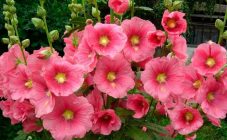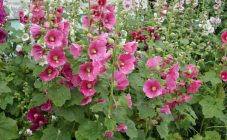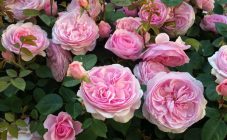Content:
The stock rose is a charming plant that strikes with its beauty in the summer. Knowledge of the intricacies of planting, growing and care will allow flower growers to easily engage in the cultivation of this flower in any region of Russia.
Description of the plant
The perennial stock rose is popularly called mallow. Other names are kalachik, mallow. Mallow is interpreted as the queen of all flowers or a magic talisman. A plant native to Europe. There are annual, perennial, biennial varieties.
Perennial varieties for 3 years of life begin to lose their attractiveness, often disappear.
Belongs to the Malvaceae family. This is a herbaceous medicinal and ornamental plant, which is why it is used in medicine, cosmetology.
There are 85 genera and about 1600 species.
A tall plant resembles a stem with a rosette of large leaves. The upper half has large flowers.
The legend of the emergence of the mallow flower
Rose stock application
During this time, he learned to extract the maximum benefit from the plant:
- This plant is used in medicine. The Bible mentions that Moses treated sick with a decoction of flowers for fever. Nowadays, it is brewed for the treatment of colds, flu prevention.
- Pure mallow leaves are applied to the skin for burns, furunculosis.
- From the flowers of the rose stem, paint, natural dyes are obtained.
- Tincture of the root is used as compresses and to treat inflammation in the body.
- Mixes for weight loss are made from petals. Some girls lose weight by 4.5 kg per month, subject to proper nutrition.
- Mallow flower extract is added to tonics and creams. It tones the skin, removes oily sheen, and makes the skin velvety.
- Young shoots, leaves are added to salads, soups, pastry creams.
- Extracts from plants are used to relieve pain in diseases of the upper respiratory tract, inflammation, gastritis, hemorrhoids.
Plant characteristic
| Description Rose stock by parameters | |
|---|---|
| Plant parameters | Growth is forced from 30 to 250 cm. The stem is large, it can be thick, straight or thin. At the base it is covered with fine hairs. Depending on the species, it can be straight, recumbent or ascending. The leaves are round, heart-shaped, incised, with 5-7 lobes. They look drooping, petiolate. |
| Bloom | It begins to bloom profusely in late July - early August. Pollinated by bees. Flowers are located in the axils of the leaves of 5-6 pieces. Each has 5 petals with a large number of stipules, the calyx is divided into 5 parts. Diameter - 5-15 mm. Ovaries are multi-celled.There are 2 types of inflorescences: racemose, spike-like. Depending on the variety, there are white, yellow flowers. There are a large number of red and purple shades. There are glossy, semi-double, double flowers. Each nest has 1 ovule. |
| Fruit | The seeds are located in a box or in a roll, buns with a hole in the middle, equally cut into narrow halves. The seeds are presented in the form of light and dark scales. |
| Root system | It is presented as a long branched root. Goes deep underground. |
| Frost resistance | It tolerates severe frosts - about -30 degrees Celsius. The maturity of the shoots affects winter hardiness. |
| Drought tolerance | Unpretentious plant. Thanks to the root system that goes deep into the ground, it tolerates droughts. |
| Preservation | Average. Flowers in an ideal form can stand at room temperature in a vase for no more than 5-10 days. In a cold room - more than 30 days. |
Characteristics of species and varieties of crops
In an abundance of 1600 species, the most popular are those that differ from each other.
Stock rose wrinkled
In the wild, it is found in the Caucasus, the south of the non-black earth region of Russia. Height reaches 1.5 m, the plant is a perennial.
Sudanese mallow
Perennial herb. Homeland - Balkans. It grows wild in Greece and Turkey. Sudanese mallow flowers have unique properties. They are actively used for the treatment of inflammatory processes, as infusions, food additives.
It reaches a height of 2 m. The leaves are dark green. Blooms from early June to October. Inflorescences are large, black-red in color, collected at the top of the stem in an ear. There are no varieties.
Double rose stem
It grows up to 2.6 m in height. The stem is thin, ascending.
Densely double flowers are large, 13 cm in diameter, collected in inflorescences. The brushes completely cover the peduncles. It begins to bloom from the beginning of June. Flowering lasts until the end of August. A wide range of colors, combinations of different colors on one peduncle are possible. Yellow, white, pink and dark pink, red colors are more common.
Popular varieties:
- Royal - height 50 m. The shades of flowers are saturated.
- Majoretta - bright and semi-double flowers. Blooms one year after planting.
- Believe it - the colors are pink and burgundy. Double flowers, similar to peonies.
Stem rose black
The height of the ornamental plant is forced from 1 to 2.5 m. The stem is thick, short. The flowers are black, with a red tint, double flowers are more common. At the end of the stem, a spike-shaped inflorescence is formed. Blooms from July to late October.
Common varieties:
- Black Pyramid - glossy black flowers. Height - up to 2 m.
- Mulatto - height up to 1.5 m. Flowers are small, chaotically scattered along the peduncle. One of the most unpretentious, drought-resistant varieties.
Landing features
Seedlings are used by gardeners who need the flowering of the plant this season, since most varieties do not have time to bloom. Before planting, the seedling container is filled with a substrate, the seeds are laid, lightly sprinkled with earth. Cover the pots with foil, put them in a room with a temperature of at least 20 degrees Celsius.
After 15 days, the seedlings are transferred to a box. The distance of the shoots should be more than 4 cm. Every day they are ventilated, watered every 5-7 days. Planting in this way is done at the end of May.
Soil selection
A light soil that can pass moisture and air is suitable. A well stock rose will germinate on mixed soil: 2 parts of garden loose soil, 1 part of sand, 2 parts of humus.
Selection of plots
The plant prefers sunlit places. It is desirable that the site be fenced off from strong winds (it can damage delicate flowers).
Planting seeds
You need to plant seeds in warm, calm weather in open ground. Seeds are planted to a depth of 2-3 m. Seedlings appear in 3-4 weeks.
Landing scheme
Mallow is a large and tall plant. The optimum distance between seedlings is 0.5 m. When planted closer, the flowers look neglected.
Formation of culture
You need to water the sprouts constantly - 4 times a week. An adult plant is watered regularly, but not waterlogging the soil. You need to pour water at the root so as not to get on the leaves.
Gardeners tie tall crops to a peg. Old, faded, diseased parts are regularly cut off. Cleaning is carried out every 2-3 months during the flowering season, since the plant actively begins to shed its leaves for 2 years of life.
In autumn and spring, it is worth loosening the soil to provide the roots with access to air and moisture. The main task of the summer resident is not to damage the root system.
Diseases and pests of culture
The plant is unpretentious, but if basic conditions are not observed, it is exposed to a number of diseases:
- Spot, powdery mildew - excessive soil moisture.
- Rust - infection occurs due to the location near metal fences, structures.
- Stem cancer - the disease is caused by bacteria.
Treatment instructions:
- All infected areas are removed.
- They are treated with pharmaceutical preparations: fungicides, colloidal sulfur solution, trichodermine.
Mallow often affects aphids - flowers, buds begin to turn yellow. For treatment, a soap solution is used.
The stock rose is a godsend for gardeners and summer residents of Russia who wish to decorate their garden with beautiful, lush flowers. The main thing is to follow the recommendations and rules so that the plant feels comfortable.
















